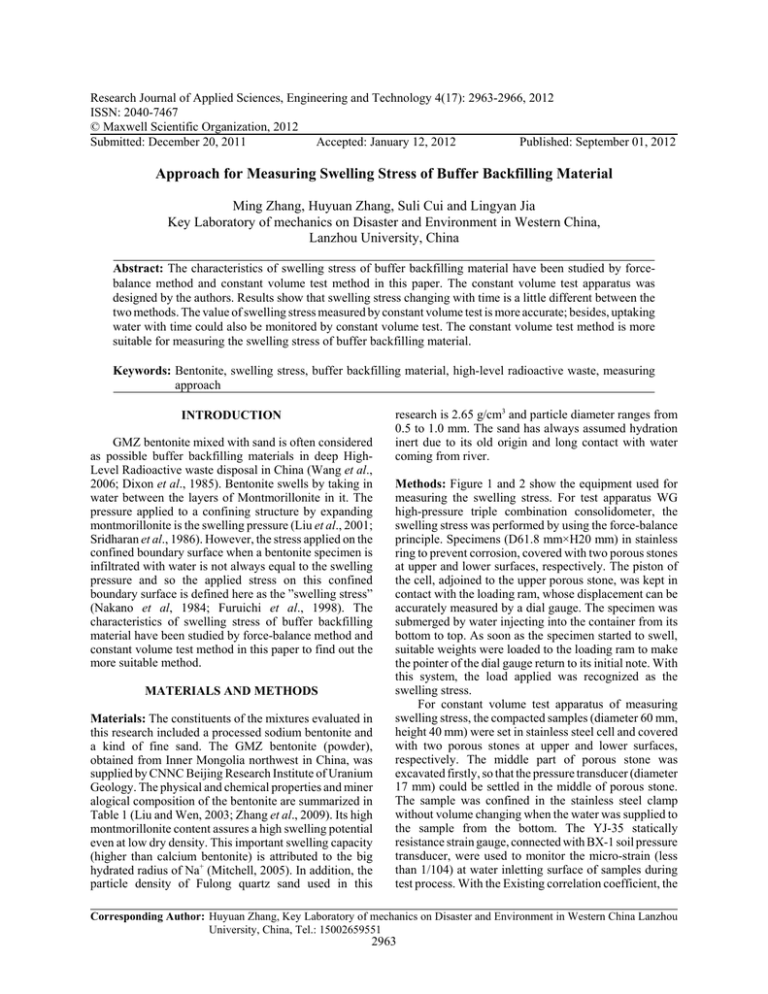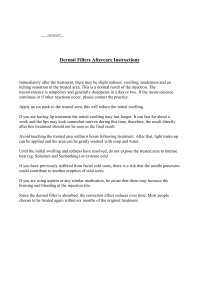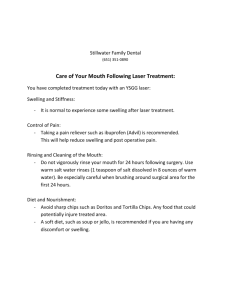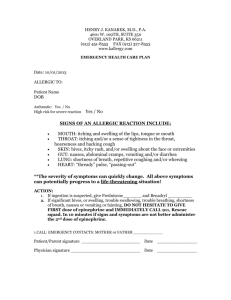Research Journal of Applied Sciences, Engineering and Technology 4(17): 2963-2966,... ISSN: 2040-7467
advertisement

Research Journal of Applied Sciences, Engineering and Technology 4(17): 2963-2966, 2012 ISSN: 2040-7467 © Maxwell Scientific Organization, 2012 Submitted: December 20, 2011 Accepted: January 12, 2012 Published: September 01, 2012 Approach for Measuring Swelling Stress of Buffer Backfilling Material Ming Zhang, Huyuan Zhang, Suli Cui and Lingyan Jia Key Laboratory of mechanics on Disaster and Environment in Western China, Lanzhou University, China Abstract: The characteristics of swelling stress of buffer backfilling material have been studied by forcebalance method and constant volume test method in this paper. The constant volume test apparatus was designed by the authors. Results show that swelling stress changing with time is a little different between the two methods. The value of swelling stress measured by constant volume test is more accurate; besides, uptaking water with time could also be monitored by constant volume test. The constant volume test method is more suitable for measuring the swelling stress of buffer backfilling material. Keywords: Bentonite, swelling stress, buffer backfilling material, high-level radioactive waste, measuring approach INTRODUCTION GMZ bentonite mixed with sand is often considered as possible buffer backfilling materials in deep HighLevel Radioactive waste disposal in China (Wang et al., 2006; Dixon et al., 1985). Bentonite swells by taking in water between the layers of Montmorillonite in it. The pressure applied to a confining structure by expanding montmorillonite is the swelling pressure (Liu et al., 2001; Sridharan et al., 1986). However, the stress applied on the confined boundary surface when a bentonite specimen is infiltrated with water is not always equal to the swelling pressure and so the applied stress on this confined boundary surface is defined here as the ”swelling stress” (Nakano et al, 1984; Furuichi et al., 1998). The characteristics of swelling stress of buffer backfilling material have been studied by force-balance method and constant volume test method in this paper to find out the more suitable method. MATERIALS AND METHODS Materials: The constituents of the mixtures evaluated in this research included a processed sodium bentonite and a kind of fine sand. The GMZ bentonite (powder), obtained from Inner Mongolia northwest in China, was supplied by CNNC Beijing Research Institute of Uranium Geology. The physical and chemical properties and miner alogical composition of the bentonite are summarized in Table 1 (Liu and Wen, 2003; Zhang et al., 2009). Its high montmorillonite content assures a high swelling potential even at low dry density. This important swelling capacity (higher than calcium bentonite) is attributed to the big hydrated radius of Na+ (Mitchell, 2005). In addition, the particle density of Fulong quartz sand used in this research is 2.65 g/cm3 and particle diameter ranges from 0.5 to 1.0 mm. The sand has always assumed hydration inert due to its old origin and long contact with water coming from river. Methods: Figure 1 and 2 show the equipment used for measuring the swelling stress. For test apparatus WG high-pressure triple combination consolidometer, the swelling stress was performed by using the force-balance principle. Specimens (D61.8 mm×H20 mm) in stainless ring to prevent corrosion, covered with two porous stones at upper and lower surfaces, respectively. The piston of the cell, adjoined to the upper porous stone, was kept in contact with the loading ram, whose displacement can be accurately measured by a dial gauge. The specimen was submerged by water injecting into the container from its bottom to top. As soon as the specimen started to swell, suitable weights were loaded to the loading ram to make the pointer of the dial gauge return to its initial note. With this system, the load applied was recognized as the swelling stress. For constant volume test apparatus of measuring swelling stress, the compacted samples (diameter 60 mm, height 40 mm) were set in stainless steel cell and covered with two porous stones at upper and lower surfaces, respectively. The middle part of porous stone was excavated firstly, so that the pressure transducer (diameter 17 mm) could be settled in the middle of porous stone. The sample was confined in the stainless steel clamp without volume changing when the water was supplied to the sample from the bottom. The YJ-35 statically resistance strain gauge, connected with BX-1 soil pressure transducer, were used to monitor the micro-strain (less than 1/104) at water inletting surface of samples during test process. With the Existing correlation coefficient, the Corresponding Author: Huyuan Zhang, Key Laboratory of mechanics on Disaster and Environment in Western China Lanzhou University, China, Tel.: 15002659551 2963 Res. J. App. Sci. Eng. Technol., 4(17): 2963-2966, 2012 Fig. 1: Apparatus A: WG high-pressure triple combination consolidometer Fig. 2: Apparatus B: Constant volume test apparatus for swelling stress swelling stress could be calculated quickly. Besides, the weight of stainless steel clamp, including sample and two designed by the authors could monitor the water in taking Table 1: Characteristics of GMZ bentonite and quartz sand used GMZ bentonite ------------------------------------------------------------------------------------Particle Bentonite Specific Air-dried Plastic limit diameter content surface water content 10.53% 32.43% Main<2mm 74% 570 m2/g Fulong sand ------------------------------------------------------------------------------------Liquid Specific Particle Silica Specific limit gravity diameter content gravity 228% 2.71 main 99.45% 2.65 0.5~1.0 mm process easily. As shown in Fig. 4, in the initial stage of test, the swelling stress increased rapidly, due to the absorbing a lot of water. Then, the swelling stress increased slowly, because the speed of absorbing water decreased. That is to say, the swelling stress development process of bentonite with time shows phase characteristics. It becomes clear that the microscopic structure of buffer changed from drastic to stable in the water infiltration process. It is known that there are three methods to measure swelling stress (Sridharan et al., 1986; Ye et al., 2007). The path of the two methods in this paper could be expressed in Fig. 5. The specimen was submerged by water injecting into the container from its bottom to top. As soon as the specimen porous stones, was measured in the test process. The layout of the Fig. 3: Layout of the constant volume test apparatus 40 2500 Water intake Swelling stress Water intake/g 1500 20 1000 10 500 0 0 1000 2000 3000 4000 Time/min 5000 Swelling stress (kPa) 2000 30 0 6000 Fig. 4: Water intake and swelling stress evolution in the test Fig. 5: Paths of the two methods for measuring swelling stress 2964 Res. J. App. Sci. Eng. Technol., 4(17): 2963-2966, 2012 Swelling stress/kPa Figure 6 shows the evolution of swelling stress both using consolidometer apparatus and constant volume apparatus. The initial dry density of the two samples is 1.70g/cm3, the initial water content is 12.4% and the sand ratio is 50%. The results shows, swelling stress changing with time is similar, increased rapidly firstly, then increased slowly. Besides, the maximum swelling stress measured by the constant volume test apparatus is a litter more than swelling stress measured by consolidometer. Apparatus A Apparatus B 500 400 300 200 100 0 0 1000 2000 3000 4000 Time/min 5000 0 6000 CONCLUSION Fig. 6: Change processes of swelling stress with time constant volume test apparatus for swelling stress is showed in Fig. 3. The value of swelling stress measured by constant volume test is more accurate; besides, uptaking water with time could also be monitored by constant volume test. It is clear that this method is more suitable for measuring the swelling stress of buffer backfilling material. RESULTS AND DISCUSSION ACKNOWLEDGMENT Figure 4 shows the evolution of water intake in the constant volume test performed with distilled water. The dry density of sample is 1.70 g/cm3, sand ratio is 0%. It becomes clear that the water intake capacity at the middle stage of test was higher, what reveals a higher permeability. The water intake process does not is not linear increase. The test confirmed that the apparatus designed by the authors could monitor the water in taking process easily. As shown in Fig. 4, in the initial stage of test, the swelling stress increased rapidly, due to the absorbing a lot of water. Then, the swelling stress increased slowly, because the speed of absorbing water decreased. That is to say, the swelling stress development process of bentonite with time shows phase characteristics. It becomes clear that the microscopic structure of buffer changed from drastic to stable in the water infiltration process. It is known that there are three methods to measure swelling stress (Sridharan et al., 1986; Ye et al., 2007). The path of the two methods in this paper could be expressed in Fig. 5. The specimen was submerged by water injecting into the container from its bottom to top. As soon as the specimen swelled a little, which could be observed by dial gauge, suitable weights were loaded to the loading ram to make the pointer of the dial gauge return to its initial note. The test process was made of a lot of circulating from swelling a little to swelling zero. It is easy to understand that this process could influence the microstructure of bentonite, ultimately effect the result of the swelling strain. For constant volume test apparatus designed by the authors, the maximum strain is less than 1/104, which could be recognized as no strain compared with the other method. So it could be indicated that the swelling stress measured by constant volume test apparatus could be more accurate. The authors are grateful to the State Commission of Science and Technology for National Defense Industry of China for the financial supports (No. [2007]834) and all participants of CNN BeijingResearch Institute of Uranium Geology for Very useful feedback on the work presented in here. REFERENCES Dixon, D.A., M.N. Gray and A.W. Thomas, 1985. A study of the compaction properties of potential claysand buffer mixtures for use in nuclear fuel waste disposal. Eng. Geol., 21: 247-255. Furuichi, M., K. Okutsu, T. Tanaka and K. Tanai, 1998. A Study of the sealing concept of High-Level Radioactive waste repository. J. Geotech. Engine. Japan Soc. Civil Eng., 594: 21-33 (in Japanese). Liu, Y., G. Xu, S. Liu and Z. Chen, 2001. Study on compatibility and swelling property of buffer/backfill material for HLW repository. Uranium Geol., 17(1): 44-47 (in Chinese) Liu, Y.M. and Z.J. Wen, 2003. Study of clay-based materials for the repository of high level radioactive waste. Mineral Petrol, 3(4): 42-45 (in Chinese). Mitchell, J.K., 2005. Fundamentals of Soil Behavior. John Wiley and Sons, New York. Nakano, M., Y. Amemiya, K. Fujii, T. Ishida and A. Ishii, 1984. Infiltration and expansive pressure in the confined unsaturated clay. Tran. Japanese Soc. Irrigation Drainage Reclamation Engine., 112: 55-66, (In Japanese). Sridharan, A., A.S. Rao and P.V. Sivapullaiah, 1986. Swelling pressure of clays. Geotech. Test. J., 9(1): 24-33. 2965 Res. J. App. Sci. Eng. Technol., 4(17): 2963-2966, 2012 Wang, J., R. Su, B. Chen, Ju, W., S. Rui, C. Weiming, G. Yonghai, J. Yuanxin et al., 2006. Deep geological disposal of high-level radioactive wastes in china. Chinese J. Rock Mechanics Engine., 25(4): 649-658 (in Chinese) Ye, W.M. T. Schanz, L.X. Qan, et al., 2007. Characteristics of swelling pressure of densely compacted Gomiaozi bentonite GMZ01. Chinese J. Rock Mechanics Engine., 26(12): 3861-3865 (in Chinese). Zhang, H.Y, J. Liang and J.S. Liu, 2009. Compaction properties of bentonite-sand mixture as buffer material for HLW disposal. Chinese J. Rock Mech. Eng., 12(12): 2585-2592 (In Chinese) 2966








